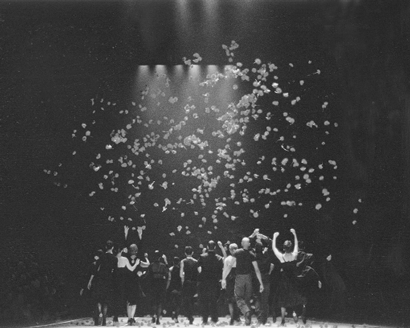An alternately vague and overdramatic “Exodo” from Danzahoy
Film director Godfrey Reggio used accelerated time lapse techniques in “Koyaanisqatsi”—Hopi for “life out of balance”—to depict the alienating effects of technology and overdevelopment in a world torn from its soul. Luz Urdaneta, perhaps influenced by Reggio’s 1983 work, employed similar strategies in “Exodo” (Spanish for “exodus”), a New York premiere performed at the Joyce Theater by Danzahoy, Venezuela’s preeminent contemporary dance troupe.
Program notes for the evening-length piece loosely alluded to social turmoil in urban Latin America, and the choreography’s driven energy reflected unrest and violence. However, these thematic intentions were largely swallowed up by remarkable visual effects—by collaborators Carolina Puig and Jacques Broquet—and ultimately compromised by the choreographer’s desire to please.
The opening moments of “Exodo,” on a stage lit only by black-and-white video projections, foreshadowed these drawbacks. A broad beam of light descended from behind and above the audience and slid an astonishingly huge full moon along the backdrop. On a scratchy recording, a man sang classic tango as other looming images washed across a group of black-clad dancers. Manic and indistinct, the projections gave us the sensation of speeding down a highway at night, trails of light streaming on either side. Variations of this imposing imagery appeared throughout the dance, altering both lighting and mood.
For a dance set to a range of tango music and influenced by Venezuela’s celebratory joropo rhythms, “Exodo” exuded a lot of distress. The strict unison of the ensemble dancing that dominated the work’s earlier parts suggested a tight and stagnant, if energetic, conformity with troubling undercurrents. In a later segment, red light saturated the stage, and dancers moved as if to scoop up the bloody red light into their mouths. Many repeated movements suggested binging, purging, and hyperventilating.
Ideas were ventured but rarely elaborated or sustained. A lovely, imaginative trio seemed to have dropped into the midst of the overall madness. It offered clever, fluent partnering and a satisfying design of circling paths, circling bodies, and a circling of relationships among a man and two women literally going around together. Urdaneta also flirted with tango’s complex erotic code in a male duet—two gang members?—and in simultaneous duets for three mixed-sex couples. But too much of “Exodo” felt simultaneously vague and over dramatized.
Near the end, dancers spilled toward a blood-red layer of carnations—perhaps a foot in width—that spanned the lip of the stage. Some peered over the edge into warm light that transformed their facial features into masks. Others ran forward and retreated. One man dangled backward, carnations in each fist. A woman laughed, nearly crying. They all regrouped and slowly, carefully gathered each and every carnation, then rose to their feet, bouquets cradled in their arms as they gazed at us for a very long time. The music continued.
The audience, fooled into thinking the dance had ended, applauded. But, one by one, the dancers turned, walked to the rear of the stage, and deposited their armload of flowers. The applause continued a little bit longer, even as dancers began to extract movements from the piece’s earlier sections, recycling them in a strangely upbeat way. This maneuver seemed manipulative and forced, as if Urdaneta wanted us to leave with a good impression.
gaycitynews.com



































